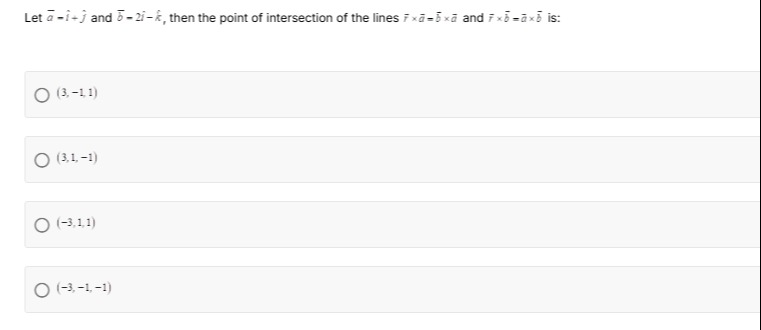Question
Question: Let $\overline a = \hat i + \hat j$ and $\overline b = 2\hat i - \hat k$, then the point of intersec...
Let a=i^+j^ and b=2i^−k^, then the point of intersection of the lines r×a=b×a and r×b=a×b is:

(3,-1,1)
(3,1,-1)
(-3,1,1)
(-3,-1,-1)
(3,1,-1)
Solution
The given equations for the lines are:
- r×a=b×a
- r×b=a×b
The first equation can be rewritten as (r−b)×a=0. This implies that the vector r−b is parallel to a. Thus, r−b=ka for some scalar k, which gives the parametric equation of the first line as r=b+ka.
Similarly, the second equation can be rewritten as (r−a)×b=0. This implies that the vector r−a is parallel to b. Thus, r−a=mb for some scalar m, which gives the parametric equation of the second line as r=a+mb.
We are given: a=i^+j^=(1,1,0) b=2i^−k^=(2,0,−1)
The parametric equations of the lines are: Line 1: r=(2,0,−1)+k(1,1,0)=(2+k,k,−1) Line 2: r=(1,1,0)+m(2,0,−1)=(1+2m,1,−m)
To find the point of intersection, we equate the components of r from both equations: 2+k=1+2m (x-component) k=1 (y-component) −1=−m (z-component)
From the y-component, we get k=1. From the z-component, we get m=1.
Now, we check if these values satisfy the x-component equation: 2+k=2+1=3 1+2m=1+2(1)=3 The x-components match, so the lines intersect.
Substitute the value of k=1 into the equation for Line 1: r=(2+1,1,−1)=(3,1,−1)
Alternatively, substitute the value of m=1 into the equation for Line 2: r=(1+2(1),1,−1)=(3,1,−1)
Both methods yield the same point of intersection. The point of intersection is (3,1,−1).
